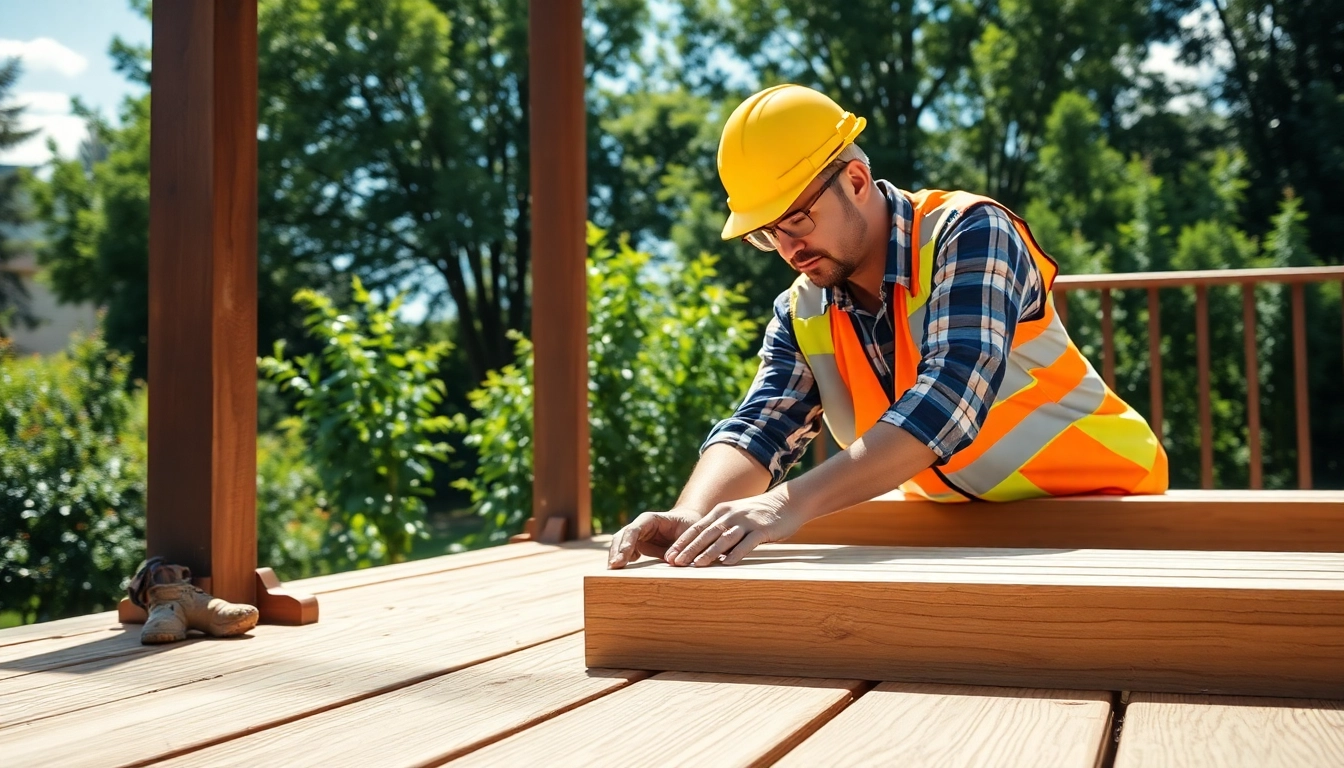Understanding Deck Construction Basics
Building a deck is a rewarding project that enhances your outdoor living space and can significantly add value to your home. Before embarking on this journey, it’s crucial to understand the basics of deck construction. This emphasizes the importance of durable materials, proper planning, and adherence to local building codes. In this section, we’ll explore the different types of decks, key components involved in the construction, and the tools needed for a successful project.
Types of Decks: Which One Suits You?
When it comes to deck construction, choosing the right type of deck is vital. There are various styles to consider, each offering unique features and benefits. Here are some of the most common types:
- Wood Decks: These are classic, traditional decks made from lumber. They’re aesthetically pleasing and can be customized but require regular maintenance.
- Composite Decks: Composed of recycled wood fibers and plastic, composite decks mimic the appearance of wood but offer superior durability and less maintenance.
- Vinyl Decks: Vinyl is a low-maintenance option available in many colors and styles. It’s resistant to fading, scratching, and mold.
- Aluminum Decks: These decks are highly durable, resistant to rust, and low-maintenance, making them suitable for various weather conditions.
- Raised Decks: Perfect for sloped backyards, these decks are elevated off the ground and often require railing systems for safety.
- Ground-Level Decks: These decks are built close to the ground, making them easy to access and an excellent option for smaller spaces.
Key Components of Deck Construction
A well-constructed deck comprises multiple components that work together to create a safe and functional outdoor space. Here are the essential parts:
- Footings: These are the concrete anchors that provide a stable foundation for the deck.
- Posts: Vertical supports that hold up the beams and the entire deck structure.
- Beams: Horizontal members that support the decking and are attached to the posts.
- Joists: Installed perpendicularly to the beams, these provide additional support for the decking boards.
- Decking: The surface layer that you walk on, typically made from wood or composite materials.
- Railing: Essential for safety, railings keep users secure while adding style.
Tools Required for Building a Deck
Before beginning your deck construction project, gather these essential tools:
- Power drill
- Saw (circular and miter saws are commonly used)
- Level
- Measuring tape
- Hammer
- Fasteners (screws and nails)
- Safety gear (gloves and goggles)
- Construction adhesive
- Post hole digger
- Square
Planning Your Deck Construction Project
Effective planning is the backbone of a successful deck construction project. It involves understanding your specific needs, adhering to regulations, and creating a realistic budget. Below, we’ll break down the key steps to help you plan thoroughly.
How to Assess Your Space and Needs
Begin by evaluating your yard space, the deck’s purpose, and your desired features. Consider the following:
- Size: How much space do you have for a deck? Measure your yard to determine the available area.
- Usage: Will the deck be primarily for entertaining, relaxation, or both? This will influence your design choices.
- Access: Ensure the deck is easily accessible from your home, possibly through sliding doors or steps.
- Orientation: Consider the sun’s path and privacy from neighbors to decide the best location.
Permits and Regulations for Deck Construction
Before breaking ground, check local building codes and regulations to ascertain if you need a permit. Common requirements might include:
- Height restrictions
- Setback distances from property lines
- Material specifications
- Required inspections during different phases of construction
Engaging with your local building department early in the planning process can save time and prevent headaches down the line.
Budgeting for Your Deck: Costs and Materials
Your budget will heavily influence the design and materials you choose for your deck. Here’s a simple way to break down potential costs:
- Materials: Depending on your choice, materials can range from budget-friendly treated lumber to higher-end composite boards.
- Labor: If hiring a contractor, consider labor costs which can significantly increase the total expense.
- Design Features: Elements such as lighting, built-in seating, and custom railings can add to your budget.
The average cost to build a deck can range from $3,920 to $10,540, with an approximate cost of $21 per square foot. Planning to incorporate items like weather-resistant furniture and lighting is a smart addition to your budget.
Step-By-Step Guide to Deck Construction
Once your plans are solidified, it’s time to begin the building process. Follow this detailed step-by-step guide to ensure a successful construction:
Preparing the Site: What You Need to Know
Start the preparation process by clearing the area where the deck will be constructed:
- Remove any obstacles such as rocks, plants, or other debris.
- Mark the outline of the deck using stakes and a string line to visualize the size and shape.
- Check for underground utilities before digging and mark them.
Framing Your Deck: Techniques and Tips
The framing of the deck is crucial for its integrity. Here’s how to approach it:
- Install Footings: Dig holes for your footings according to your design and local codes. Footings should be below the frost line in colder climates.
- Attach Posts: Securely install vertical posts into the footings, using brackets and concrete for additional stability.
- Set Beams: Install horizontal beams atop the posts to form the primary support structure for the deck.
- Lay Joists: Position joists across the beams, ensuring they’re evenly spaced (typically 16 inches on center) and flush with the edges.
- Support Joists: If your deck design requires, add bridging or blocking between joists for additional structural support.
Finishing Touches in Deck Construction
With the frame in place, it’s time to add the finishing elements:
- Install Decking Boards: Fasten your chosen decking material onto the frame. Leave expansion gaps between boards for drainage.
- Add Railing: If your deck is elevated or located in a high-traffic area, installing sturdy railings enhances safety and style.
- Finalize Details: Consider adding accessories like built-in seating, planter boxes, or lighting to enhance functionality and aesthetics.
Common Challenges in Deck Construction
Even with thorough planning and execution, challenges can arise during construction. Awareness and preparation can help mitigate these issues.
Weather Considerations When Building a Deck
Weather conditions play a significant role in deck construction:
- Rain can hinder work and cause safety risks with slippery surfaces.
- Extreme heat can affect materials, making some expand or warp.
- Plan construction during the favorable seasons; spring and fall typically offer the best weather conditions.
Addressing Structural Concerns in Deck Design
Ensure that your deck design adheres to engineered specifications to prevent structural issues:
- Choose quality materials that meet safety standards.
- Consult a structural engineer or experienced contractor if unsure about load-bearing requirements.
- Perform regular inspections to check for signs of wear or weakness in the structure.
Mitigating Mistakes in Deck Construction
Common mistakes can lead to costly repairs. To avoid issues, consider the following:
- Double-check measurements before cutting materials to minimize waste.
- Have a second pair of eyes during installation to catch any potential errors.
- Document each step in your process for future reference and learning.
Deck Maintenance and Best Practices
Maintaining your deck is crucial for longevity and safety. Proper upkeep ensures that the deck remains attractive and functional for years to come.
Long-term Care for Your Deck
Effective long-term maintenance practices include:
- Washing the deck regularly to remove dirt, algae, and any debris.
- Sealing or staining wood decks every few years to protect against moisture and UV damage.
- Scheduling routine inspections to address wear and tear before they worsen.
Seasonal Maintenance Tips
Each season brings unique maintenance needs:
- Spring: Clean your deck and apply a fresh coat of sealant if needed to prepare for summer use.
- Summer: Inspect for signs of wear and ensure furniture does not scratch the surface.
- Fall: Clean fallen leaves and debris to prevent mold buildup and clogging gutters.
- Winter: Remove snow cautiously, using a shovel rather than a metal object to avoid damaging the surface.
Signs Your Deck Needs Repairs
Be vigilant about the health of your deck. Here are common warning signs:
- Cracks in the decking or railings can indicate deterioration.
- Loose boards or fasteners signify that repairs are necessary.
- Excessive bending or warping of deck boards demands immediate attention to prevent accidents.


